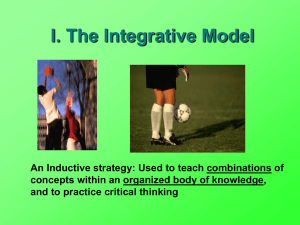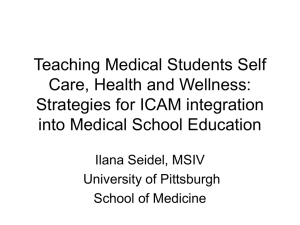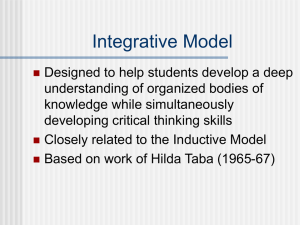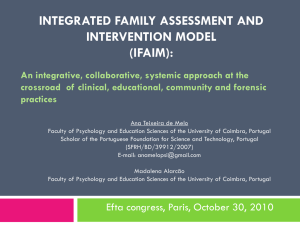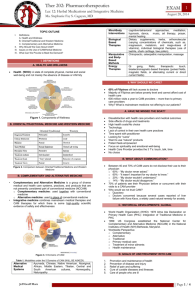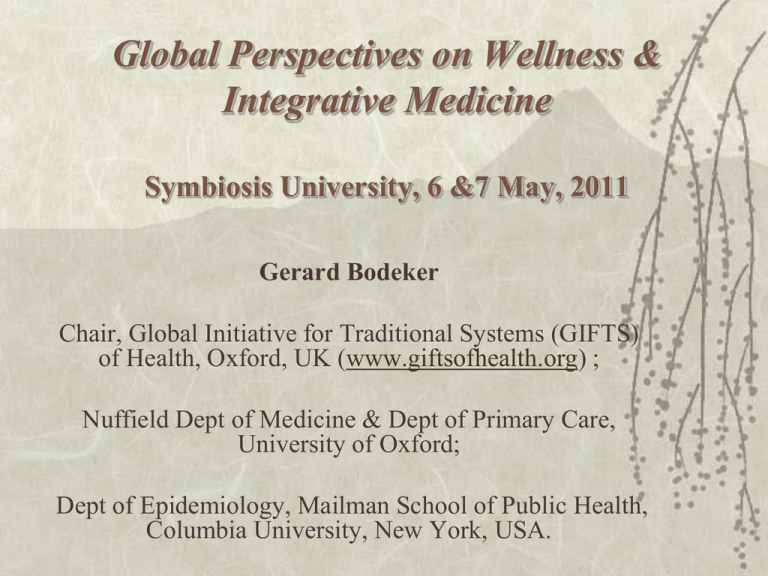
Global Perspectives on Wellness &
Integrative Medicine
Symbiosis University, 6 &7 May, 2011
Gerard Bodeker
Chair, Global Initiative for Traditional Systems (GIFTS)
of Health, Oxford, UK (www.giftsofhealth.org) ;
Nuffield Dept of Medicine & Dept of Primary Care,
University of Oxford;
Dept of Epidemiology, Mailman School of Public Health,
Columbia University, New York, USA.
What is wellness?
According to the US National Wellness Institute (NWI),
wellness is: “an active process through which people
become aware of, and make choices towards, a more
successful existence”.
NWI identifies six dimensions of wellness:
Social; Occupational; Spiritual; Physical; Emotional;
Intellectual.
LOHAS – Lifestyles of Health And Sustainability – is a
framework that focuses on “health & Fitness; the
environment; personal development; sustainable living;
and social justice.”
A Global Perspective on Natural Healthcare
Wellness is now a $1trillion industry
(SRI International 2008).
Within this, Asian healthcare systems and
traditions are globalizing
(WHO Global Atlas on Traditional, Complementary &
Alternative Medicine, 2005)
.
.
.
.
Global Spa Industry
,
Integrative Medicine - Consortium of
Academic Health Centers for Integrative Medicine:
(46 leading academic medical centers in North America)
Integrative Medicine:
Is the practice of medicine that reaffirms the importance of
the relationship between practitioner and patient,
focuses on the whole person,
is informed by evidence, &
makes use of all appropriate therapeutic approaches,
healthcare professionals and disciplines to achieve optimal
health and healing.
IM Globalizing
Integrative Medicine, a concept & approach
that has gained ground in the first decade of
the 21st Century, is now quite global.
A Google search for ‘Integrative Medicine’
yields over 2 million hits.
And the same search for ‘Integrated
Medicine’ yields 9.25 million hits.
Use of complementary medicine providers in
Britain (Ong, Peterson, Bodeker & Stewart-Brown, 2002)
The Oxford Healthy Life Survey (HLS III) - used
UK-SF36
8,889: representative of local population for age, sex
and social class
Women outnumbered men 2:1 in their use of CP
services.
One in four people (25% ) who use CP's do so for
lifestyle reasons (under 45 age group)
– i.e. Wellness.
UK: 4 counties in England
(Ong, Peterson, Bodeker & Stewart-Brown, 2002)
Predictors of CAM use were:
long-standing illness
non-manual occupation
.female (2:1)
high levels of GP service use
age over 35 (mean age was 43.2)
60% of CAM users reported chronic illness or disability
(mostly back pain & bowel problems)
Regardless of whether chronic illness was reported, CAM
provider users reported poorer health than nonusers
.
Very
much a case of integrated
medicine –
Yet integrated largely by the
consumer rather than by the
healthcare system.
Some Models of IM Practice:
Modern Medical Doctors practice TCAM,
e.g. medical acupuncture
Modern Medical Doctors work in same
practice with licensed TCAM practitioners:
a)
b)
Joint or integrated case management
Independent or parallel case management
Cross-referral between health professionals
Evidence:
.
Safety & Efficacy
Cochrane & Complementary Medicine
The CM field has constructed a database on
randomized controlled clinical trials &
controlled clinical trials in CM.
Over 5,800 trials have been identified and
CM Field members regularly hand search
over 40 journals.
Chinese language studies? German? Etc..
Safety
Databases & physicians handbooks available on safety of:
Herbal medicines, Herb-drug interactions; Other TCAM practices
UK:
Royal Pharmaceutical Society of Great Britain:
‘MedicinesComplete’ database includes Herbal Medicines and Dietary
Supplements: www.medicinescomplete.com
USA:
Natural Medicines comprehensive database
Australia:
L. Braun & M Cohen (2010):
“Herbs & Natural Supplements: An Evidence Based Guide”
Natural Medicines Comprehensive Database
Search - enter any natural product name, disease or condition, or
drug name...gives objective product information, Effectiveness
Ratings, or potential interactions with drugs, etc.
Natural Product Effectiveness Checker - tells the level of
effectiveness for natural products used for various medical
conditions.
Natural Product / Drug Interaction Checker - tells potential
interactions between any natural product and any drug.
Automatically checks for interactions with EACH
INGREDIENT of each product.
Disease / Medical Conditions Search - shows medical
conditions, and allows the reader to see which natural products
might be effective.
Search Colleagues Interact - questions, answers, and
comments posted by other health professionals.
MedicinesComplete
www.medicinescomplete.com
The Royal Pharmaceutical Society’s database
“MedicinesComplete” includes “Stockley's
Herbal Medicines Interactions”
Stockley’s covers herb-drug, herb-food and
herb-supplement interactions in over 150 of the
most commonly used herbal medicines, dietary
supplements and nutraceuticals.
The interactions are rated using three categories.
1)The weight of evidence behind the interaction,
2) the severity of the interaction & 3) action
needed to accommodate the interaction.
Regulatory Context
Need licensed TCAM professions for
integration of different health professionals
into a single available service.
This requires national &/or regional
regulation & licensure for practitioners &
products
China
(a)
(b)
In China, there is a Chinese Association of Integrative Medicine,
which organizes World Integrative Medicine Congress every 5 years.
The Capital Medicine University, Beijing, has a Dept. of Integrative
Medicine. This, in partnership with the Beijing Association of the
Integration of Traditional & Western Medicine, co-organized in
October 2010, the First Beijing Conference on Integrative Medicine.
China has at least two journals in this field: “The Chinese Journal of
Integrative Medicine” (www.cjim.cn). And “The Journal of Chinese
Integrative Medicine” www.jcimjournal.com.
The Consortium for The Globalization of Chinese Medicine
(http://www.tcmedicine.org) is engaged in active debate about:
educational curriculum for integrated Chinese medicine practitioners,
creating the requisite evidence base for IM practice of Chinese
Medicine.
India
India’s Health Secretary was reported by the national media as
stating in December 2010 that: “There is a need to bring
different systems of medicine under one roof so that the gaps
in allopathic medicine can be filled by the Indian systems of
medicine”.
India now has an Institute for Ayurveda & Integrative
Medicine (www.iaim.edu.in). This has been accredited by the
Health Ministry’s Department of AYUSH to offer a two-year
full-time course for a Post Graduate degree followed by a Post
doctoral certification. The awardees will be known as Fellows of
the Institute of Ayurveda and Integrated Medicine (FIAM).
There are now two journals of Ayurveda & Integrative Medicine
in India: www.j-aim.co.in, www.jreim.com.
.
WHO Global Atlas
of
Traditional, Complementary
& Alternative Medicine
(TCAM)
.
.
WHO Global Atlas of Traditional &
Complementary Medicine is designed to record,
analyze and map the status of policy in this sector
around the world.
.
.
.
Challenges
. Challenges to the development of IM include
the availability of an acceptable body of
evidence – efficacy & safety & herb-drug;
differing paradigms of health, diagnostics,
disease status & progression;
Including a wellness as well as illness focus
traditional concepts and forms of science vs
the modern scientific method;
and the impact of professionalization on
traditional systems of pedagogy & practice.
Herbal Home Gardens
In India, Healthcare follows food & shelter as the
3rd leading source of expenditure for the poor.
In a programme covering 6,000 rural villages and
comprising 150,000 HHG’s, herbal home garden
seedlings of a set of 20 medicinal plants from 1215 species that are useful for common ailments
were grown and sold to rural households by
Women Self-Help Groups in the I-AIM network.
These groups were trained by I-AIM in raising,
distributing and demonstrating the use of the
plants for the conditions. Through participatory
rural appraisal a list was developed of plants
specific to each of the regions in which the project
was conducted.
.
.
Economics
Health expenditure incurred by non-HHG households was
approximately 5 times greater than that of adopters.
HHG adopters spend Rs. 92 on an average in 3 months
towards their family’s primary healthcare while the nonadopters spend Rs. 478 in that time.
The cost of an HHG package at Rs 100 (for the plants) and
maintenance cost of Rs. 50-60 per year cost a household
only Rs. 160 (US$3.5).
The village resource persons earned at least Rs. 500
(US$11.11) per month through the sale of seedlings and
training households in growing and using the plants,
thereby promoting income generation for local women.
In India’s planning for reduction in national expenditure on
pharmaceuticals – especially by the poor – the HHG model
is an important direction to be considered.
.
Some Dimensions of
the Wellness Market
Anti-Ageing
Euromonitor International: "Ageing consumers are looking
to do all they can to help avoid age-related illnesses such as
arthritis, osteoporosis and prostate problems.
Many see vitamins and dietary supplements as the answer.
Therefore, vitamins and dietary supplements remain the
bedrock of OTC healthcare sales, accounting for around
40% of global OTC sales.
Products such as calcium (taken to improve bone health),
glucosamine (for arthritis) and co-enzyme Q10 (for
cardiovascular health) are the main engines for growth,
especially among the affluent, older generations.
Wellness & Beauty
Research shows that US consumers are becoming
increasingly convinced that beauty starts with "wellness".
Retailers are increasingly linking their beauty lines to nonbeauty products, positioning health products, like vitamins, in
close proximity to cosmetics.
Manufacturers are introducing cosmetic lines that tout claims
often found in OTC products, featuring, for example,
featuring anti-wrinkling and acne-fighting ingredients.
The World Market for Cosmetics and Toiletries:
http://www.euromonitor.com/cosmeticsandtoiletries
Integrative medicine, Wellness
& Health Spas
Within the spa industry, medical spas or
‘medispas’ are the fastest growing sector.
They are also a new ‘front line’ of integrative
medicine development
.
Traditional Knowledge
& Wellness
Meditation & Metabolic Syndrome
Randomized, placebo-controlled clinical trial of 16
weeks.
TM or active control treatment (health education),
matched for frequency and time, at an academic
medical centre, involving 103 subjects with stable
Cardiovascular Heart Disease.
CHD patients improved the following components of
the metabolic syndrome :
– blood pressure
– insulin resistance
– cardiac autonomic nervous system tone
(Arch Intern Med. 2006)
YOGA
US reviews of studies suggest that yoga may
reduce many insulin-resistant syndrome related risk
factors for CVD,
improve clinical outcomes
may aid in the management of CVD
(Innes et al 2005).
Yoga - Reduces age related deterioration in
cardiovascular functions (Bharshankar et al 2003).
“India: Diabetes Capital of the World”
White Rice: Diabetes Risk for 1.2 billion
Research at Harvard’s Department of Nutrition found a highly
significant difference in rates of Type 2 diabetes between those who
ate a lot of white rice and those who ate more brown rice.
Those who consumed at least five servings (150 grams each) of white
rice per week had a 17% higher risk of getting type 2 diabetes than
those who hardly ate any white rice at all.
People eating at least two servings of brown rice a week had an 11 %
lower chance of getting the disease than those who ate less than one
serving of it a month.
The researchers calculated that replacing white with brown rice
would lower the chances of type 2 diabetes by 16%.
Polishing rice removes the bran and germ & uncovers the endosperm.
This raises rice’s glycaemic index & strips away vitamins (A,B,K,E),
fibre, magnesium and essential amino acids that can help prevent
diabetes.
Sun et al, Arch. Intern. Med. (2010).
Copper & Serious Pathogens
Research at the Institute of Ayurveda & Integrative Medicine, Bangalore,
found
investigating the ancient Ayurvedic recommendation of leaving water o
vernight in a copper pot, found that all water borne pathogens, includin
g cholera, e-coli, shigella, typhoid, etc were killed.
-------------------------------------------A UK study in 2010 found that copper fittings rapidly killed bugs on hospital
wards, succeeding where other infection control measures failed.
During the ten-week trial at Selly Oak Hospital, Birmingham, a set of taps, a
lavatory seat and a push plate on an entrance door were replaced with copper
versions. They were swabbed twice a day for bugs and the results compared
with a traditional tap, lavatory seat and push plate elsewhere in the ward.
The copper items had up to 95 per cent fewer pathogens on their surface
whenever they were tested.
Lab tests show that copper kills the deadly MRSA and C difficile superbugs.
It also kills the flu virus and E coli.
-----------------------
TRADITIONAL KNOWLEDGE & SPAS
In the evolving spa world, indigenous themes have
emerged as a significant trend , especially in destination
spas and in rural and regional settings where traditions are
strong and local health knowledge is lively.
SpaFinder noted in its ‘Ten Spa Trends to Watch for in
2007’: “Spa guests are rewarding a spa's efforts to
incorporate authentic indigenous treatments, hire local staff,
and contribute to the community.
They're also welcoming education about local cultures and
healing traditions.”
.
UNESCO Heritage Listing
‘
.
.
.
.
.
.
.
THANK
YOU


